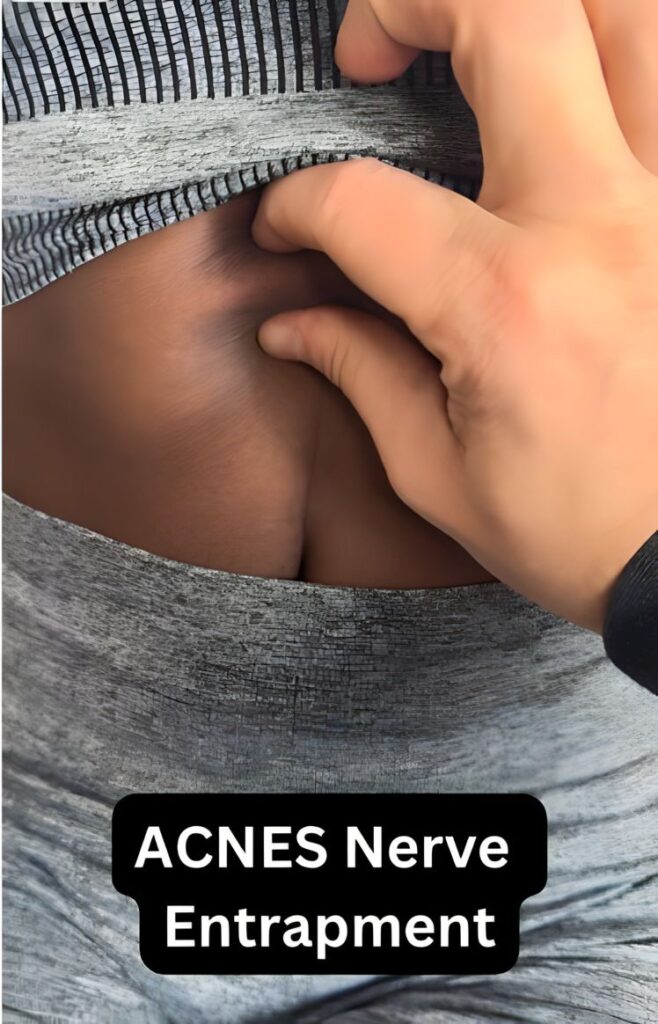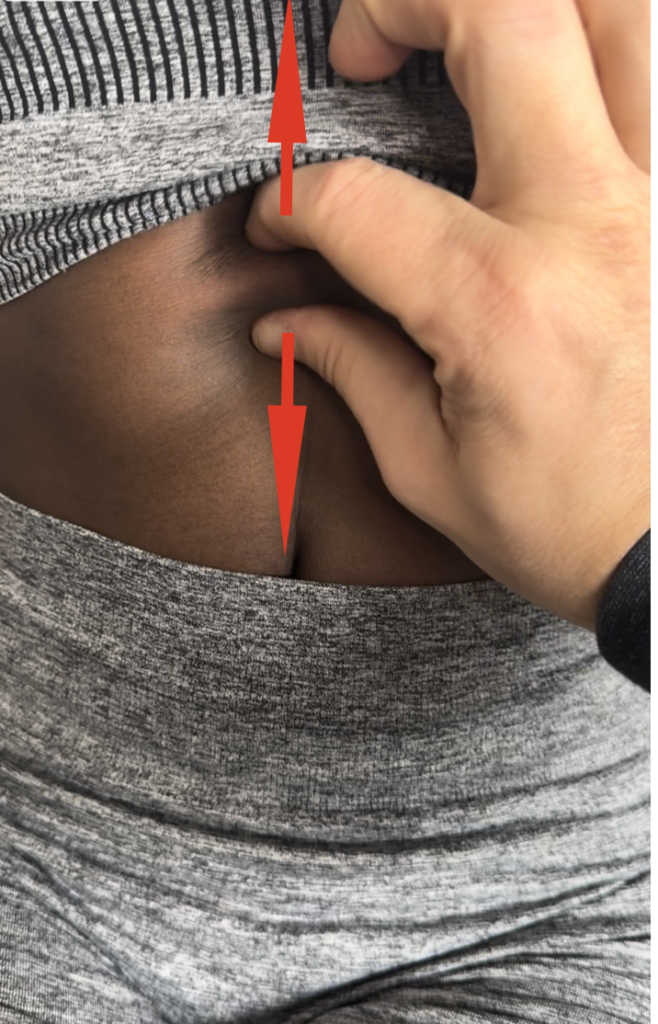Relieve Nerve Entrapment with ACNES Syndrome: Home Treatment Here

As an expert in the field of nerve entrapment, I am here to provide you with a comprehensive understanding of Anterior Cutaneous Nerve Entrapment Syndrome (ACNES). This condition is characterized by chronic abdominal pain caused by the entrapment or irritation of cutaneous nerves within the anterior abdominal wall. The impact on daily life can be profound and debilitating.
To truly comprehend, it is vital to delve into the intricate anatomy involved. The cutaneous branches originate from the lower intercostal nerves and provide sensation to specific regions of the abdomen. These nerves can become trapped within muscle fibers or scar tissue, leading to localized discomfort.
Recognizing key symptoms and indicators associated with ACNES is essential for an accurate diagnosis. Patients commonly report sharp or burning pain that may worsen with movement or pressure applied to specific trigger points along their abdomen. While this pain may radiate to adjacent areas, it typically remains concentrated within a specific region.
Other names:
- Intercostal nerve syndrome
- Rectus abdominis syndrome
Best At Home Treatment: Try this!
Like most nerve entrapments, there is usually some sort of physical structure compressing the nerve and causing nerve pain known as neuralgia. These set of particular nerves are cutaneous nerves, meaning that they mainly reside in the skin. The most common entrapment point of these nerves is past the muscular foreman of the rectus abdominus, causing a disruption in the oxygen supply to the nerve, known as ischemic neuropathy.
Nerve entrapments can be solved in two ways:
- Stretch or floss the nerve about the surrounding tissues
- Remove the surrounding tissues around the nerve causing the compression, usually by manual therapy or surgery.
This nerve mobilization, as home treatment, can address both issues at once without the need for surgery. Results will vary, so consult your healthcare provider.
Along the rectus abdominus, you’ll find a tender point that recreates your symptoms or is very tender. 
- Gently grab the skin over the most tender place in the front of the abdomen.
- Lift the tissue away from the body without aggressively squeezing the skin and fat between your fingers.
- Move the skin in a wiggling motion up and down for fifteen seconds.
- After the first round of treatment, check to see if symptoms have reduced. If so, then repeat 3×5 times per day until pain is reduced or eliminated.
The Rest of the article is for informational purposes; the treatment outlined above can be effective and is the easiest conservative therapy that patients can try at home. Consult your medical provider prior to performing.
The Vital Role of Accurate Diagnosis
Precise diagnosis plays a crucial role in effectively addressing ACNES. This condition is frequently encountered but often overlooked as a source of persistent abdominal pain. To accurately pinpoint, a meticulous clinical examination is paramount. This involves reviewing the patient’s medical history and conducting a focused physical assessment to identify specific indicators associated with ACNES, such as localized tenderness, trigger points, and sensory disruptions along the affected nerve pathways.
Differential diagnosis is also crucial in ensuring an accurate assessment. It involves distinguishing this condition from other potential causes of abdominal discomfort, such as gastrointestinal issues or musculoskeletal ailments. Misdiagnosis can lead to unnecessary interventions and delays in providing effective relief for individuals grappling with ACNES.
In certain instances, additional diagnostic measures may be warranted to definitively confirm the diagnosis. These could include administering local anesthetic injections at suspected trigger points to assess temporary pain relief or utilizing imaging techniques like ultrasound or MRI scans to visualize any structural irregularities within the abdominal wall.
Accurate diagnosis stands as a cornerstone in effectively addressing ACNES. A comprehensive clinical appraisal, combined with a deep understanding of the patient’s medical background and differential diagnosis, is indispensable. Diagnostic procedures, such as trigger point injections or imaging studies, may be imperative to confirm an ACNES diagnosis. By prioritizing precision in diagnosis, healthcare providers can ensure that individuals receive appropriate care tailored toward alleviating their chronic abdominal pain.
How to Diagnose
To accurately diagnose, a thorough evaluation is essential. Here, we will delve into the diagnostic procedures commonly used to identify ACNES, including the role of imaging, patient history, and physical examination.
Patient History:
-
- Gather a detailed patient history, including the location, duration, and characteristics of the pain experienced.
- Explore any past medical conditions or surgeries that may be linked to the symptoms.
- Understand activities or movements that worsen or alleviate pain to offer valuable insights for diagnosis.
Physical Examination:
-
- Perform a meticulous physical examination to pinpoint potential signs of entrapment. Carefully palpate specific areas on the abdomen to locate tender points.
- Encourage patients to communicate their pain experience when pressure is applied to certain areas.
- Conduct an abdominal wall “pinch test” by applying gentle pressure along different regions of the abdomen to elicit pain responses in some instances.
Diagnostic Tests:
-
- Local Anesthetic Injection Test: Administer local anesthetic injections at suspected trigger points identified during the physical examination. Temporary relief from pain post-injections confirms diagnosis.
- Imaging Studies: While not always necessary for confirmation, imaging studies like ultrasound or magnetic resonance imaging (MRI) can help rule out other causes of abdominal pain and visualize anatomical structures involved. Ultrasound offers real-time images for dynamic assessment during exams, while MRI provides detailed visualization of soft tissues and nerves.
Combining patient history, physical exam findings, and diagnostic tests helps establish an accurate diagnosis. While diagnostic tests are helpful tools, they should complement clinical judgment for a comprehensive evaluation.
Treatment Options
When addressing ACNES, a variety of treatment options are available to alleviate symptoms and improve quality of life. The selection of the most suitable treatment is influenced by the severity of symptoms, individual patient characteristics, and the patients’ and healthcare providers’ preferences. In this section, we will explore conservative treatment methods and surgical interventions, as well as the significance of physical therapy and lifestyle adjustments in effectively managing entrapment.
Conservative Options:
-
- Pain Management: Over-the-counter pain relievers like acetaminophen or nonsteroidal anti-inflammatory drugs (NSAIDs) can help manage mild to moderate pain.
- Topical Relief: Applying lidocaine or capsaicin-based creams directly on the affected area may temporarily relieve discomfort.
- Physical Therapy Support: Collaborating with a specialized physical therapist can be beneficial in guiding patients through exercises that strengthen abdominal muscles and enhance posture to alleviate nerve pressure.
- TENS Therapy: Transcutaneous Electrical Nerve Stimulation (TENS) utilizes low-voltage electrical currents to stimulate sensory nerves near painful areas for pain relief.
Surgical Interventions:
- If conservative treatments prove ineffective or if symptoms are severe, surgical intervention may be recommended based on individual circumstances:
-
- Neurectomy Procedure: This surgery removes a portion of entrapped nerves to disrupt abnormal signals causing pain.
- Neurolysis Surgery: Scar tissue or compressing structures around nerves are carefully dissected or removed without severing them completely.
Importance of Physical Therapy and Lifestyle Adjustments:
-
- Core Strengthening Exercises: Strengthening core muscles such as abdominals and back muscles can improve posture and reduce nerve pressure.
- Postural Correction Techniques: Maintaining proper body alignment during daily activities is crucial in preventing symptom exacerbation; guidance from a physical therapist can aid in achieving this goal.
- Ergonomic Modifications: Changing work environments or daily routines to minimize repetitive movements or prolonged positions may help alleviate symptoms.
Treatment plans should be tailored according to each patient’s unique needs. Seeking guidance from healthcare providers specializing in nerve entrapment syndromes ensures accurate diagnosis and personalized treatment recommendations.
Choosing the Best Treatment Options
Selecting the most effective treatment option for this Intercostal nerve syndrome is a critical step toward achieving optimal outcomes. Consider the following key factors when making this decision:
Key Considerations for Treatment Selection:
-
- Severity of Symptoms: The intensity and frequency of pain play a crucial role in determining the most suitable treatment approach.
- Impact on Daily Life: Evaluate how the nerve affects your daily activities and consider treatments that align with your lifestyle.
- Risks and Side Effects: Each treatment option has its own potential risks and side effects. Weigh these against the expected benefits.
- Long-Term Outlook: Some treatments offer temporary relief, while others aim for sustained improvement or resolution. Discuss your goals with your healthcare provider to set realistic expectations.
Incorporating Lifestyle and Health Factors into Decision-Making:
-
- Lifestyle Considerations: Your occupation, hobbies, and personal commitments should be factored into selecting a treatment plan that integrates seamlessly into your routine.
- Overall Health Status: Certain medical conditions or medications may impact the safety or suitability of specific treatments. Be transparent about any relevant information with your healthcare provider.
Importance of Consultation with Healthcare Provider:
-
- Expert Advice: Seek guidance from a specialist in nerve entrapment to gain valuable insights into available treatments tailored to your case.
- Collaborative Decision-Making: Engage in open dialogue with your healthcare provider to actively participate in decisions regarding your care, ensuring alignment on goals and expectations.
Recognize that there is no universal solution for treating nerve entrapments, as what works for one person may not work for another. By gaining a comprehensive understanding of your condition and working closely with your healthcare provider, you can determine the best course of action suited to your needs.
Tips and Strategies for Management
Living with this syndrome can present challenges, but there are effective strategies to help alleviate symptoms and enhance your quality of life. Consider the following expert tips:
Pain Relief Methods:
-
- Utilize heat or cold therapy to ease discomfort in the affected area.
- Practice deep breathing exercises and relaxation techniques to reduce muscle tension.
- Consult your healthcare provider about using over-the-counter pain medications like NSAIDs.
Physical Therapy:
-
- Engage in tailored physical therapy sessions designed specifically for ACNES.
- Collaborate with a proficient physical therapist who can lead you through exercises targeting abdominal muscle strength and posture improvement.
Lifestyle Adjustments:
-
- Avoid activities that worsen your symptoms.
- Maintain proper posture, especially during prolonged periods of sitting or standing.
- Integrate gentle stretching routines into your daily regimen.
Support Networks:
-
- Seek understanding and encouragement from friends, family, or support groups familiar with your situation.
- Consider connecting with online communities where individuals facing similar challenges offer mutual support.
Mental Well-being:
-
- Acknowledge the mental health implications of chronic pain and seek professional assistance if necessary.
- Explore stress management practices such as mindfulness meditation or counseling services.
Dietary Habits:
-
- Follow a well-rounded diet comprising fruits, vegetables, whole grains, lean proteins, and healthy fats to promote overall wellness.
- Stay adequately hydrated by consuming ample water throughout the day.
Every person’s journey with rectus abdominis syndrome is one-of-a-kind, making it vital to find the best approach for you. These tips are just a beginning – seek personalized advice from your healthcare provider for optimal guidance.
The Future of Treatment: Innovations and Research
With ongoing research and innovation, exciting new treatments are on the horizon to revolutionize how we manage nerve entrapment syndromes. Stay updated on cutting-edge developments in this field to discover potential solutions that could greatly improve your quality of life. Consult with specialized healthcare professionals for the latest information and personalized advice.
Reach out to Dr. Dean (sports chiropractor) by texting (best), calling 323-354-6077, or emailing at drjustindean@gmail.com
Our editorial practices include evidence-based practices, interventions, and recommendations.
References
Cofano G, LaCourt S, Nguyen S. Conservative management of anterior cutaneous nerve entrapment syndrome: A case report. J Bodyw Mov Ther. 2021;26:141-146. doi:10.1016/j.jbmt.2020.12.012
Oor JE, Ünlü Ç, Hazebroek EJ. A systematic review of the treatment for abdominal cutaneous nerve entrapment syndrome. Am J Surg. 2016;212(1):165-174. doi:10.1016/j.amjsurg.2015.12.013
Written and reviewed by Dr. Justin Dean, DC on March 6, 2024
Learn about our Editorial Process


Dr. Justin Dean is the only one I trust my whole family with. NCA is outrageously effective.
Sean Rad
Founder of Tinder

Dr. Dean fixed my chronic tension headaches in a visit and had me SLIVING (slaying + living) in no time!
Paris Hilton
Entrepreneur, DJ, Media Personality

Within 15 seconds of working with him I squatted pain free for the first time in 8 years. Dr. Dean gave me my life back.
Sam Moore
Former Elite Volleyball Player

I have trusted Dr. Dean with my elite athletes and my own nagging injuries! I recommend his services to any athlete looking for support.
Bradford Scott
Head Sports Performance Coach, Atlanta Braves
